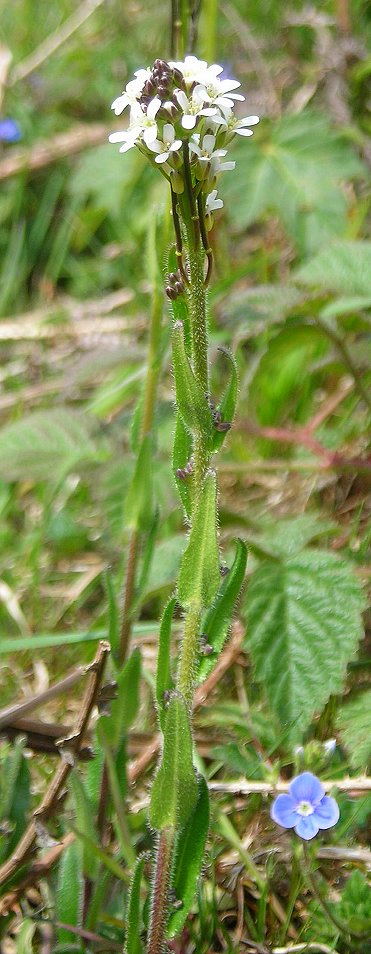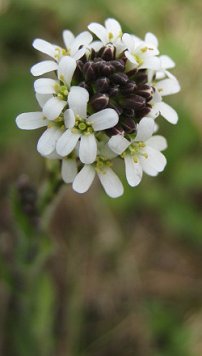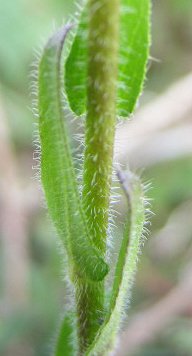Hutton Common 21st May 2011
notes by Gill Smith (species lists at the end)
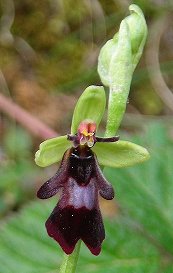 A dozen members met at the cattle grid south of Hutton-le-Hole village on a cloudy, but dry morning; later the day improved with the sun breaking through. Hutton Common is a wonderful site, known as a hot-spot for wild flowers, with limestone and neutral grassland, a steep rocky slope, scrub and woodland. There are old records of frog and bee orchids on this site, but neither has been seen recently. We hoped to find these but did not, although we did see many other plants, including the locally rare houndstongue and deadly nightshade along with several orchids (including a couple of new sites for fly orchids). Many of the plants were very short, some of the fly orchids barely 4in tall, probably as a result of the very dry early Spring (our total rainfall for March and April combined was less than 8mm, or a third of an inch).
A dozen members met at the cattle grid south of Hutton-le-Hole village on a cloudy, but dry morning; later the day improved with the sun breaking through. Hutton Common is a wonderful site, known as a hot-spot for wild flowers, with limestone and neutral grassland, a steep rocky slope, scrub and woodland. There are old records of frog and bee orchids on this site, but neither has been seen recently. We hoped to find these but did not, although we did see many other plants, including the locally rare houndstongue and deadly nightshade along with several orchids (including a couple of new sites for fly orchids). Many of the plants were very short, some of the fly orchids barely 4in tall, probably as a result of the very dry early Spring (our total rainfall for March and April combined was less than 8mm, or a third of an inch).
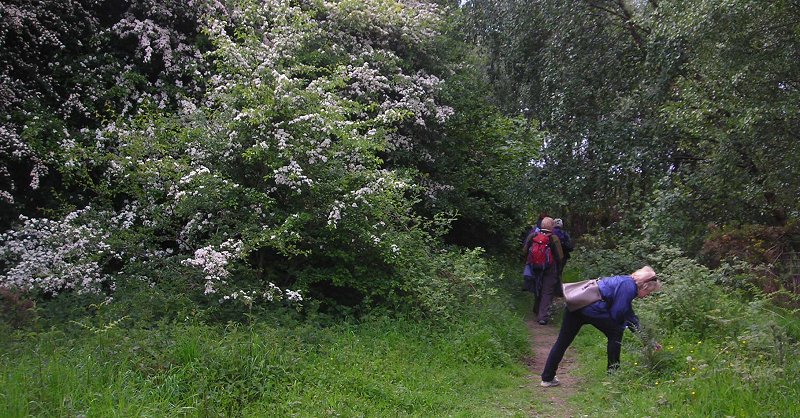
We walked (slowly) along the top of the common parallel to the road before joining the road down to the ford, passing the small house known as Treacle Castle (though its proper name according to the map is Yoadwath Villa). The verges of this road are very rich botanically, including a few plants of houndstongue, one of which was just coming into flower. Later in the year the seeds of this plant are very intriguing, rather like a cushion with four rounded sections. There was a 7-spot ladybird sunning itself on a leaf nearby.
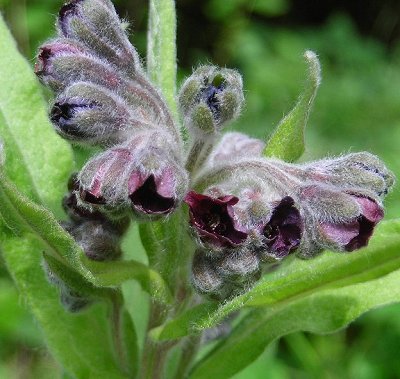
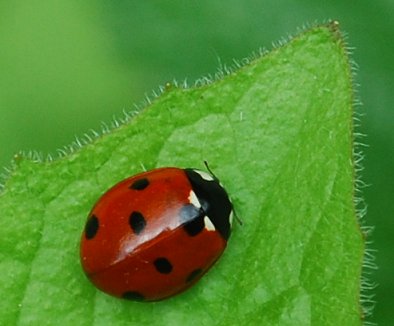
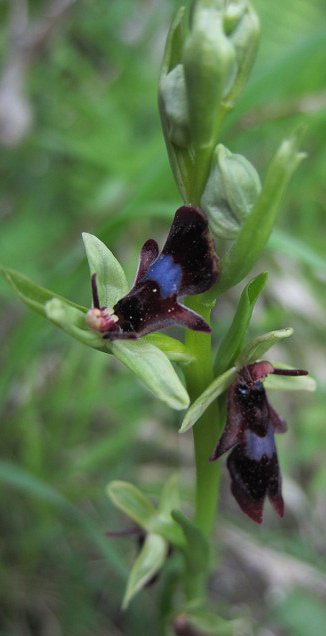 We stopped for lunch by the river at the bottom and then walked through the woodland, gradually climbing back up the bank. In the woods fly and greater butterfly orchids were in flower. Orchids are fascinating for all sorts of reasons, not least the fact that their flowers turn over as they open (in fact most orchid flowers are upside down, and you can see a twist in the stalk). I love this picture showing one of the “flies” mid-turn. These flowers have evolved to resemble female flies so closely that the males try and mate with them, picking up pollen from the orchid in the process and transferring it to another flower thus pollinating it. Extraordinary!
We stopped for lunch by the river at the bottom and then walked through the woodland, gradually climbing back up the bank. In the woods fly and greater butterfly orchids were in flower. Orchids are fascinating for all sorts of reasons, not least the fact that their flowers turn over as they open (in fact most orchid flowers are upside down, and you can see a twist in the stalk). I love this picture showing one of the “flies” mid-turn. These flowers have evolved to resemble female flies so closely that the males try and mate with them, picking up pollen from the orchid in the process and transferring it to another flower thus pollinating it. Extraordinary!
There are also early purple orchids here, but they were almost finished, and the curious green-flowered twayblades, which are also members of the orchid family. This rather fine specimen in bud (below) has germander speedwell growing at its feet.
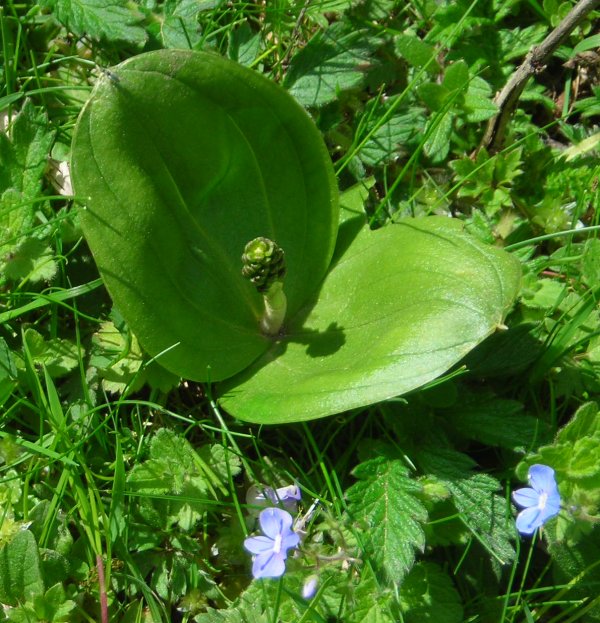
Greater butterfly orchids are scattered throughout these woods, but only a few are accessible from the path. They can grow up to a foot or so tall but this year most are much shorter. The close-up shows the “pollinia” or pollen-bearing structures diverging and widely spaced, which shows we have the larger of our two native butterfly orchids here. The long spurs are filled with nectar, and these flowers are pollinated by moths, mostly at dusk or in the night. The flowers are said to develop a fragrance in the evening and also reflect light (possibly ultraviolet) so they almost glow in the dark. An interesting theory which I must test one day....
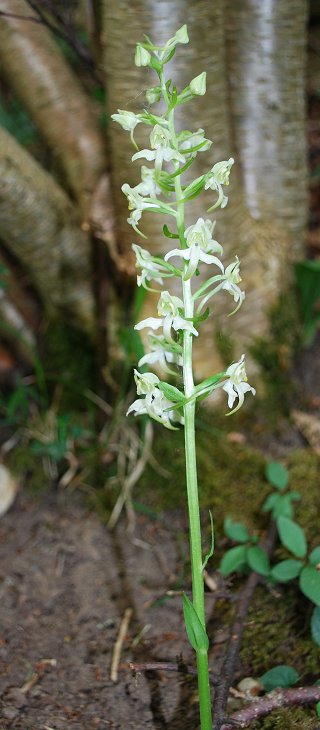
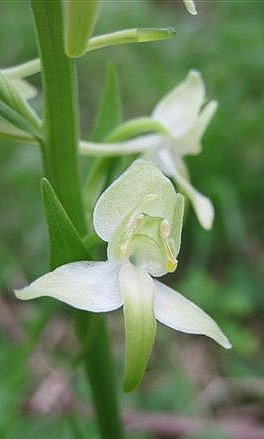
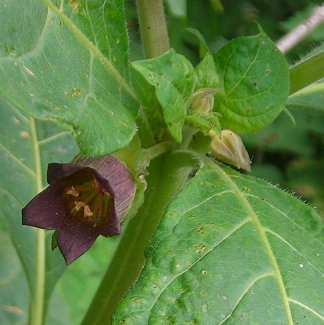 Finally we emerged at the top near some old quarries and saw many different plants, including limestone specialists such as rockrose and the leaves of ploughman’ spikenard and great mullein, as well as common species like wild strawberry and common storksbill (related to the cranesbills, but with fern-like divided leaves).
Finally we emerged at the top near some old quarries and saw many different plants, including limestone specialists such as rockrose and the leaves of ploughman’ spikenard and great mullein, as well as common species like wild strawberry and common storksbill (related to the cranesbills, but with fern-like divided leaves).
We looked in vain for the bee orchids but did see some deadly nightshade in flower (left). This remarkable plant may have escaped from an old monastic physic garden, but it seems very happy in the wild here – as well as in Spaunton Quarry nearby. Later the peculiar purple flowers produce black berries which are of course poisonous. I also managed to get a shot of a striking red cardinal beetle.
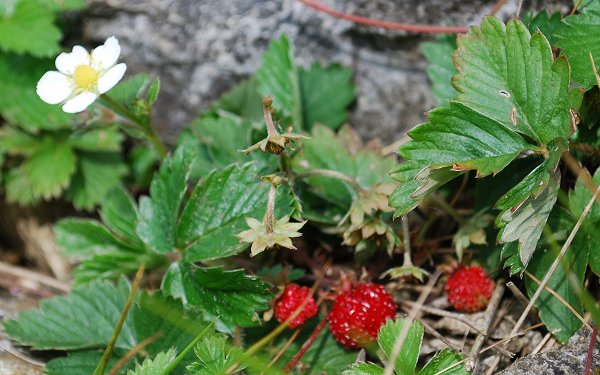
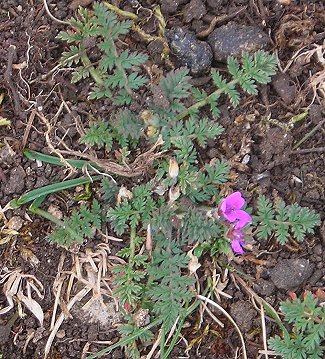
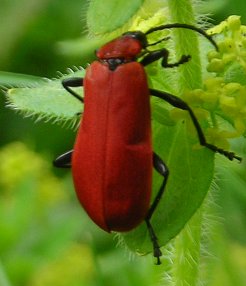
There was a small patch of hairy rock-cress, which is rare in Ryedale though I have seen it on the Wolds. It is a curious little plant that holds its leaves and seedpods upright against the stem as the close-up shows – as well as revealing the hairs!
In addition to the flora we saw or heard several birds and insects, including quite a few ladybirds and the rather fine cardinal beetle pictured above. Jim was studying the spiders and showed us one particular specimen, of a female carrying her clutch of eggs under her abdomen. Unfortunately she did not sit still enough for a photo!
Birds
Woodpigeon, Willow Warbler, Chiffchaff, Jackdaw, Chaffinch, Blackcap, Blackbird, Great Tit, Song Thrush, Carrion Crow, Rook, Long-tailed Tit, Robin, Swift, Tawny Owl (dead), Swallow, Grey Wagtail, Jay, Lapwing, Pheasant and Red-legged Partridge (thanks Jim for the list).
Butterflies
Orange Tip, Large White, Small White and Brimstone.
Other insects:
7-spot ladybird and Cardinal Beetle Pyrochroa coccinea (thanks Pauline for the id).
Snail
Banded Snail (Cepaea hortensis).
Tick
Ixodes ricinus (beaten from gorse). Commonly found on sheep and deer.
Spider list will follow
Plants
| English |
Latin |
| Agrimony |
Agrimonia eupatoria |
| Ash |
Fraxinus excelsior |
| Avens water |
Geum rivale |
| Avens wood |
Geum urbanum |
| Bedstraw heath |
Galium saxatile |
| Bedstraw lady’s |
Galium verum |
| Beech |
Fagus sylvatica |
| Birdsfoot trefoil |
Lotus corniculatus |
| Bittercress wavy |
Cardamine flexuosa |
| Black bryony |
Tamus communis |
| Black meddick |
Medicago lupulina |
| Blackthorn |
Prunus spinosa |
| Bluebell |
Hyacinthoides non-scripta |
| Bracken |
Pteridium aquilinum |
| Bramble |
Rubus fruticosus agg. |
| Bugle |
Ajuga reptans |
| Burdock lesser |
Arctium minus |
| Buttercup bulbous |
Ranunculus bulbosus |
| Buttercup creeping |
Ranunculus repens |
| Buttercup meadow |
Ranunculus acris |
| Chervil rough |
Chaerophyllum temulem |
| Cinquefoil creeping |
Potentilla reptans |
| Cleavers |
Galium aparine |
| Coltsfoot |
Tussilago farfara |
| Common rockrose |
Helianthemum nummularium |
| Common twayblade |
Listera ovata |
| Copper beech |
Fagus sylvatica purpurea |
| Cowslip |
Primula veris |
| Cranesbill cut-leaved |
Geranium dissectum |
| Cranesbill dovesfoot |
Geranium molle |
| Crosswort |
Cruciata laevipes |
| Cuckoo flower |
Cardamine pratensis |
| Daisy |
Bellis perennis |
| Dandelion |
Taraxacum agg. |
| Deadly nightshade |
Atropa belladonna |
| Dog rose |
Rosa canina |
| Dogs mercury |
Mercurialis perennis |
| Elder |
Sambucus nigra |
| Elm wych |
Ulmus glabra |
| Enchanter’s nightshade |
Circaea lutetiana |
| Eyebright |
Euphrasia agg. |
| Fairy flax |
Linum catharticum |
| False oxlip |
Primula x polyantha |
| Fern broad buckler |
Dryopteris dilatata |
| Fern male |
Dryopteris filix-mas |
| Field madder |
Sherardia arvensis |
| Field maple |
Acer campestre |
| Figwort common |
Scrophularia nodosa |
| Forget-me-not field |
Myosotis arvensis |
| Foxglove |
Digitalis purpurea |
| Grass cocksfoot |
Dactylis glomerata |
| Grass quaking |
Briza media |
| Gooseberry |
Ribes uva-crispa |
| Gorse |
Ulex europaeus |
| Great mullein |
Verbascum thapsus |
| Ground ivy |
Glechoma hederacea |
| Hawkbit rough |
Leontodon hispidus |
| Hawkweed mouse-ear |
Pilosella officinarum |
| Hawthorn |
Crateagus monogyna |
| Hazel |
Corylus avellana |
| Hedge woundwort |
Stachys sylvatica |
| Herb robert |
Geranium robertianum |
| Hogweed |
Heracleum sphondylium |
| Holly |
Ilex aquifolium |
| Honeysuckle |
Lonicera periclymenum |
| Horse chestnut |
Aesculus hippocastanum |
| Houndstongue |
Cynoglossum officinale |
| Knapweed common |
Centaurea nigra |
| Lady’s mantle |
Alchemilla xanthochlora |
| Lord and ladies |
Arum maculatum |
| Marjoram |
Origanum vulgare |
| Meadowsweet |
Filipendula ulmaria |
| Milkwort common |
Polygala vulgaris |
| Mint apple |
Mentha x villosa |
| Mouse-ear common |
Cerastium fontanum |
| Mouse-ear sticky |
Cerastium glomeratum |
| Nipplewort |
Lapsana communis |
| Oak |
Quercus spp |
| Orchid common spotted |
Dactylorhiza fuchsii |
| Orchid early purple |
Orchis mascula |
| Orchid fly |
Ophrys insectifera |
| Orchid fragrant TBC |
Gymnadenia conopsea |
| Orchid greater butterfly |
Platanthera chlorantha |
| Oxeye daisy |
Leucanthemum vulgare |
| Parsley cow |
Anthriscus sylvestris |
| Parsley piert |
Aphanes arvensis |
| Pearlwort procumbent |
Sagina procumbens |
| Pignut |
Conopodium majus |
| Plantain greater |
Plantago major |
| Plantain ribwort |
Plantago lanceolata |
| Plum wild |
Prunus domestica |
| Primrose |
Primula vulgaris |
| Ragwort |
Senecio jacobaea |
| Red bartsia |
Odontites vernus |
| Red campion |
Silene dioica |
| Red clover |
Trifolium pratense |
| Red currant |
Ribes rubrum |
| Rock-cress hairy |
Arabis hirsute |
| Rosebay willowherb |
Chamerion angustifolium |
| Salad burnet |
Sanguisorba minor |
| Sandwort three-nerved |
Moehringia trinervia |
| Sandwort thyme-leaved |
Arenaria serpylifolia |
| Sanicle wood |
Sanicula europaea |
| Sedge carnation |
Carex, panacea |
| Sedge glaucous |
Carex flacca |
| Sedge wood |
Carex sylvatica |
| Selfheal |
Prunella vulgaris |
| Sheep’s sorrel |
Rumex acetosella |
| Shepherd’s purse |
Capsella burse-pastoris |
| Silver birch |
Betula pendula |
| Silverweed |
Potentilla anserina |
| Speedwell common field |
Veronica persica |
| Speedwell germander |
Veronica chamaedrys |
| Speedwell heath |
Veronica officinalis |
| Speedwell thyme-leaved |
Veronica serpylifolia |
| Speedwell wall |
Veronica arvensis |
| Speedwell wood |
Veronica montana |
| St John’s-wort perforate |
Hypericum perforatum |
| St John’s-wort hairy |
Hypericum hirsutum |
| Stitchwort greater |
Stellaria holostea |
| Storksbill |
Erodium cicutarium |
| Strawberry barren |
Potentilla sterilis |
| Strawberry wild |
Fragaria vesca |
| Sycamore |
Acer pseudoplatanus |
| Thistle creeping |
Cirsium arvense |
| Thistle marsh |
Cirsium palustre |
| Thistle musk |
Carduus nutans |
| Thistle spear |
Cirsium vulgare |
| Thistle woolly |
Cirsium eriophorum |
| Tormentil |
Potentilla erecta |
| Tutsan |
Hypericum androsaemum |
| Vetch bush |
Vicia sepium |
| Vetch common |
Vicia sativa |
| Vetchling meadow |
Lathyrus pratensis |
| Violet common dog |
Viola riviniana |
| Violet early dog |
Viola reichenbachiana |
| Violet hairy |
Viola hirta |
| Violet sweet |
Viola oderata |
| Water pepper |
Polygonum hydropiper |
| Wavy bittercress |
Cardamine flexuosa |
| White clover |
Trifolium repens |
| Wild thyme |
Thymus polytrichus |
| Woodrush heath |
Luzula multiflora |
| Wood sage |
Teucrium scorodonia |
| Yarrow |
Achillea millefolium |
145 plants
© Ryedale Natural History Society 2011 Photos © Gill Smith, Pauline Popely, Michael Bliss & Ryedale Natural History Society
|
Back to the Index page |
 A dozen members met at the cattle grid south of Hutton-le-Hole village on a cloudy, but dry morning; later the day improved with the sun breaking through. Hutton Common is a wonderful site, known as a hot-spot for wild flowers, with limestone and neutral grassland, a steep rocky slope, scrub and woodland. There are old records of frog and bee orchids on this site, but neither has been seen recently. We hoped to find these but did not, although we did see many other plants, including the locally rare houndstongue and deadly nightshade along with several orchids (including a couple of new sites for fly orchids). Many of the plants were very short, some of the fly orchids barely 4in tall, probably as a result of the very dry early Spring (our total rainfall for March and April combined was less than 8mm, or a third of an inch).
A dozen members met at the cattle grid south of Hutton-le-Hole village on a cloudy, but dry morning; later the day improved with the sun breaking through. Hutton Common is a wonderful site, known as a hot-spot for wild flowers, with limestone and neutral grassland, a steep rocky slope, scrub and woodland. There are old records of frog and bee orchids on this site, but neither has been seen recently. We hoped to find these but did not, although we did see many other plants, including the locally rare houndstongue and deadly nightshade along with several orchids (including a couple of new sites for fly orchids). Many of the plants were very short, some of the fly orchids barely 4in tall, probably as a result of the very dry early Spring (our total rainfall for March and April combined was less than 8mm, or a third of an inch).


 We stopped for lunch by the river at the bottom and then walked through the woodland, gradually climbing back up the bank. In the woods fly and greater butterfly orchids were in flower. Orchids are fascinating for all sorts of reasons, not least the fact that their flowers turn over as they open (in fact most orchid flowers are upside down, and you can see a twist in the stalk). I love this picture showing one of the “flies” mid-turn. These flowers have evolved to resemble female flies so closely that the males try and mate with them, picking up pollen from the orchid in the process and transferring it to another flower thus pollinating it. Extraordinary!
We stopped for lunch by the river at the bottom and then walked through the woodland, gradually climbing back up the bank. In the woods fly and greater butterfly orchids were in flower. Orchids are fascinating for all sorts of reasons, not least the fact that their flowers turn over as they open (in fact most orchid flowers are upside down, and you can see a twist in the stalk). I love this picture showing one of the “flies” mid-turn. These flowers have evolved to resemble female flies so closely that the males try and mate with them, picking up pollen from the orchid in the process and transferring it to another flower thus pollinating it. Extraordinary!


 Finally we emerged at the top near some old quarries and saw many different plants, including limestone specialists such as rockrose and the leaves of ploughman’ spikenard and great mullein, as well as common species like wild strawberry and common storksbill (related to the cranesbills, but with fern-like divided leaves).
Finally we emerged at the top near some old quarries and saw many different plants, including limestone specialists such as rockrose and the leaves of ploughman’ spikenard and great mullein, as well as common species like wild strawberry and common storksbill (related to the cranesbills, but with fern-like divided leaves). 


